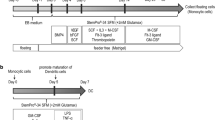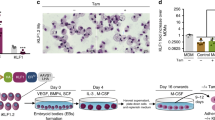Abstract
Adult stem or programmable cells hold great promise in diseases in which damaged or non-functional cells need to be replaced. We have recently demonstrated that peripheral blood monocytes can be differentiated in vitro into cells whose phenotypes resemble specialized cell types like hepatocytes and pancreatic beta cells. During phenotypic conversion the monocytes downregulate monocyte/macrophage differentiation markers being indicative of partial dedifferentiation and are partially reprogrammed to acquire a state of plasticity along with expression of various markers of pluripotency. These cells were termed “programmable cells of monocytic origin” (PCMOs). Current efforts focus on establishing culture conditions that increase both the plasticity and proliferation potential of PCMOs in order to be able to generate large amounts of blood-derived cells suitable for both autologous and allogeneic therapies.
Access this chapter
Tax calculation will be finalised at checkout
Purchases are for personal use only
Similar content being viewed by others
References
Alder JK, Georgantas RW III, Hildreth RL, Kaplan IM, Morisot S, Yu X, McDevitt M, Civin CI (2008) Kruppel-like factor 4 is essential for inflammatory monocyte differentiation in vivo. J Immunol 180:5645–5652
Boyer LA, Plath K, Zeitlinger J, Brambrink T, Medeiros LA, Lee TI, Levine SS, Wernig M, Tajonar A, Ray MK, Bell GW, Otte AP, Vidal M, Gifford DK, Young RA, Jaenisch R (2006) Polycomb complexes repress developmental regulators in murine embryonic stem cells. Nature 441:349–353
Chana G, Nogalskia M, Yurochko A (2009) Activation of EGFR on monocytes is required for human cytomegalovirus entry and mediates cellular motility. Proc Natl Acad Sci USA 106:22369–22374
Charriere GM, Cousin B, Arnaud E, Saillan-Barreau C, Andre M, Massoudi A, Dani C, Penicaud L, Casteilla L (2006) Macrophage characteristics of stem cells revealed by transcriptome profiling. Exp Cell Res 312:3205–3214
Ehnert S, Nussler AK, Lehmann A, Dooley S (2008) Blood monocyte-derived neohepatocytes as in vitro test system for drug metabolism. Drug Metab Dispos 36:1922–1929
Ehnert S, Seeliger C, Vester H, Schmitt A, Saidy-Rad S, Lin J, Neumaier M, Gillen S, Kleeff J, Friess H, Burkhart J, Stöckle U, Nussler AK (2011) Autologous serum improves yield and metabolic capacity of monocyte-derived hepatocyte-like cells: possible implication for cell transplantation. Cell Transplant 20:1465–1477
Feldman N, Gerson A, Fang J, Li E, Zhang Y, Shinkai Y, Cedar H, Bergman Y (2006) G9a-mediated irreversible epigenetic inactivation of Oct-3/4 during early embryogenesis. Nat Cell Biol 8:188–194
Forsberg M, Carlén M, Meletis K, Yeung MS, Barnabé-Heider F, Persson MA, Aarum J, Frisén J (2010) Efficient reprogramming of adult neural stem cells to monocytes by ectopic expression of a single gene. Proc Natl Acad Sci USA 107:14657–14661
Glanemann M, Gaebelein G, Nussler N, Hao L, Kronbach Z, Shi B, Neuhaus P, Nussler AK (2009) Transplantation of monocyte-derived hepatocyte-like cells (NeoHeps) improves survival in a model of acute liver failure. Ann Surg 249:149–154
Gordon S, Taylor PR (2005) Monocyte and macrophage heterogeneity. Nat Rev Immunol 5:953–964
Hutchinson JA, Riquelme P, Wundt J, Hengstler JG, Fändrich F, Ungefroren H, Clement B (2007) Could treatment with neohepatocytes benefit patients with decompensated chronic liver disease? Am J Hematol 82:947–948
Hutchinson JA, Riquelme P, Geissler EK, Fändrich F (2011) Human regulatory macrophages. Methods Mol Biol 677:181–192
Inman GJ, Nicolas FJ, Callahan JF, Harling JD, Gaster LM, Reith AD, Laping NJ, Hill CS (2002) SB-431542 is a potent and specific inhibitor of transforming growth factor-β superfamily type I receptor-like kinase (ALK) receptors ALK4, ALK5, and ALK7. Mol Pharmacol 62:65–74
Kuwana M, Okazaki Y, Kodama H, Izumi K, Yasuoka H, Ogawa Y, Kawakami Y, Ikeda Y (2003) Human circulating CD14+ monocytes as a source of progenitors that exhibit mesenchymal cell differentiation. J Leukoc Biol 74:833–845
Lamba D, Modjtahedi H, Plan N, Ferns G (2004) EGF mediates monocyte chemotaxis and macrophage proliferation and EGF receptor is expressed in atherosclerotic plaques. Atherosclerosis 176:21–26
Mikkelsen TS, Hanna J, Zhang X, Ku M, Wernig M, Schorderet P, Bernstein BE, Jaenisch R, Lander ES, Meissner A (2008) Dissecting direct reprogramming through integrative genomic analysis. Nature 454:49–55
Nolan T, Girolamo N, Goroneo M, Wakefield D (2004) Proliferative effects of heparin-binding epidermal growth factor-like growth factor on pterygium epithelial cells and fibroblasts. Invest Ophthalmol Vis Sci 45:110–113
Pufe T, Petersen W, Fändrich F, Varoga D, Wruck CJ, Mentlein R, Helfenstein A, Hoseas D, Dressel S, Tillmann B, Ruhnke M (2008) Programmable cells of monocytic origin (PCMO): a source of peripheral blood stem cells that generate collagen type II-producing chondrocytes. J Orthop Res 26:304–313
Romagnani P, Annunziato F, Liotta F, Lazzeri E, Mazzinghi B, Frosali F, Cosmi L, Maggi L, Lasagni L, Scheffold A, Kruger M, Dimmeler S, Marra F, Gensini G, Maggi E, Romagnani S (2005) CD14+CD34low cells with stem cell phenotypic and functional features are the major source of circulating endothelial progenitors. Circ Res 97:314–322
Ruhnke M, Ungefroren H, Nussler A, Martin F, Brulport M, Schormann W, Hengstler JG, Klapper W, Ulrichs K, Hutchinson JA, Soria B, Parwaresch RM, Heeckt P, Kremer B, Fändrich F (2005a) Differentiation of in vitro-modified human peripheral blood monocytes into hepatocyte-like and pancreatic islet-like cells. Gastroenterology 128:1774–1786
Ruhnke M, Nussler AK, Ungefroren H, Hengstler JG, Kremer B, Hoeckh W, Gottwald T, Heeckt P, Fändrich F (2005b) Human monocyte-derived neohepatocytes: a promising alternative to primary human hepatocytes for autologous cell therapy. Transplantation 79:1097–1103
Santos-Rosa H, Schneider R, Bannister AJ, Sherriff J, Bernstein BE, Emre NC, Schreiber SL, Mellor J, Kouzarides T (2002) Active genes are tri-methylated at K4 of histone H3. Nature 419:407–411
Schiff B, McMurphy A, Jasser S, Younes M, Doan D, Yigitbasi O, Kim S, Zhou G, Mandal M, Bekele B, Holsinger F, Sherman S, Yeung S, El-Naggar A, Myers J (2004) Epidermal growth factor receptor (EGFR) is overexpressed in anaplastic thyroid cancer, and the EGFR inhibitor Gefitinib inhibits the growth of anaplastic thyroid cancer. Clin Cancer Res 10:8594–8602
Schulze M, Fändrich F, Ungefroren H, Kremer B (2005) Adult stem cells – perspectives in treatment of metabolic diseases. Acta Gastroenterol Belg 68:461–465
Seta N, Kuwana M (2010) Derivation of multipotent progenitors from human circulating CD14+ monocytes. Exp Hematol 38:557–563
Stout RD, Watkins SK, Suttles J (2009) Functional plasticity of macrophages: in situ reprogramming of tumor-associated macrophages. J Leukoc Biol 86:1105–1109
Ungefroren H, Fändrich F (2010) The programmable cell of monocytic origin (PCMO): a potential adult stem/progenitor cell source for the generation of islet cells. Adv Exp Med Biol 654:667–682
Ungefroren H, Groth S, Hyder A, Thomsen N, Hinz H, Reiling N, Grage-Griebenow E, Held-Feindt J, Schulze M, Nüssler AK, Fändrich F (2010) The generation of programmable cells of monocytic origin involves partial repression of monocyte/macrophage markers and reactivation of pluripotency genes. Stem Cells Dev 19:1769–1780
Wagers AJ, Weissman IL (2004) Plasticity of adult stem cells. Cell 116:639–648
Yan L, Han Y, Wang J, Liu J, Hong L, Fan D (2007) Peripheral blood monocytes from patients with HBV related decompensated liver cirrhosis can differentiate into functional hepatocytes. Am J Hematol 82:949–954
Zhao Y, Glesne D, Huberman E (2003) A human peripheral blood monocyte-derived subset acts as pluripotent stem cells. Proc Natl Acad Sci USA 100:2426–2431
Author information
Authors and Affiliations
Corresponding author
Editor information
Editors and Affiliations
Rights and permissions
Copyright information
© 2012 Springer Science+Business Media B.V.
About this chapter
Cite this chapter
Ungefroren, H. et al. (2012). Peripheral Blood Monocytes Can Be Induced to Acquire Stem Cell-Like Properties. In: Hayat, M. (eds) Stem Cells and Cancer Stem Cells, Volume 6. Stem Cells and Cancer Stem Cells, vol 6. Springer, Dordrecht. https://doi.org/10.1007/978-94-007-2993-3_32
Download citation
DOI: https://doi.org/10.1007/978-94-007-2993-3_32
Published:
Publisher Name: Springer, Dordrecht
Print ISBN: 978-94-007-2992-6
Online ISBN: 978-94-007-2993-3
eBook Packages: Biomedical and Life SciencesBiomedical and Life Sciences (R0)




